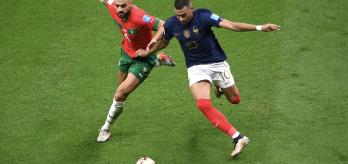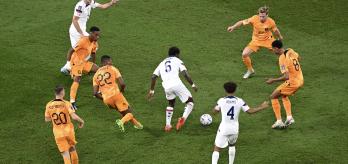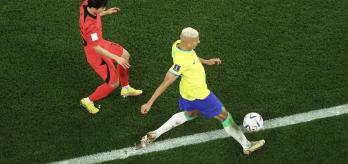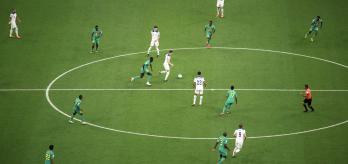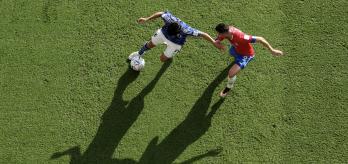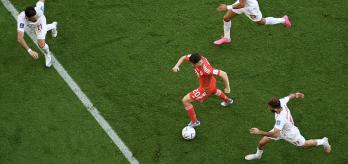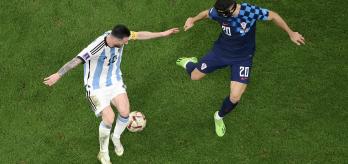Key points
-
Case studies help to unpack the finer details associated with the key physical, technical and tactical attributes associated with high-performing players.
-
Using data alongside video helps to contextualise physical performances.
-
This information could be helpful for practitioners to develop role-specific training drills because physical, technical and tactical aspects are all included.
To maximise the translation of this FIFA World Cup Qatar 2022™ physical analysis for practitioners, it was imperative that the trends were presented not only as large data sets but also communicated as case studies to unpack the finer details. A concerted effort has been made throughout to contextualise these case studies by using a combination of data and video (the latter is not presented but was viewed by the author during the analysis). Previous sections highlighted “what” the demands were for different roles and “how” these demands changed in relation to varying contexts, but this section delves deeper into the tactical reasons for “why” they exerted themselves. Thus, this section examines the physical outputs of five high-performing players in the tournament across selected positions.
CENTRE-BACK: CROATIA’S JOŠKO GVARDIOL
The outfield role that personifies defensive integrity the most is the centre-back, given that their primary focus is to nullify and delay the opposition’s attacking play1. Croatia’s Joško Gvardiol was arguably one of the highest-performing players in this role during the tournament, and this section reviews his physicality.
Gvardiol performed around 10-30% more efforts at moderate (15-20km/h) and high-intensity speeds (>20km/h) than the role average for the FIFA World Cup Qatar 2022™ (Figure 1). The centre-backs’ average for the tournament indicates that this role is primarily active out of possession, as evidenced by more moderate and high-intensity runs without the ball versus with the ball. Thus, Gvardiol regularly tracked back to provide defensive coverage at moderate and high-intensity speeds when Croatia moved into a defensive recovery or transition phase. He applied twice as many direct pressures (6 out of 9) than the role average and also regularly emphasised his physicality by winning both ground and aerial duels, in addition to plenty of blocking and tackling in the defensive third. Notably, Gvardiol performed more than twice as many high-intensity efforts with the ball than the average for this role.
The modern centre-back has similar responsibilities to those of previous generations but more emphasis is now placed on their in-possession role as they now initiate build-up and attacking play through penetrative passes and dribbles. As Croatia regularly spent time building up in the defensive third unopposed, it was not surprising to find that Gvardiol received the ball and then passed about 15% more than the role average. Gvardiol is an exceptional passer of the ball (93% pass completion) and would regularly break lines with passes or would pass through and around an opposition press or block. Although Gvardiol’s movements to receive were similar to the role average, other notable in-possession activities included occasional forward surges, dribbling to exploit space in front of him.
FULL-BACK/ WING-BACK: MOROCCO’S ACHRAF HAKIMI
The wide defensive player is the outfield role that has arguably evolved the most physically over the last decade2. The modern full-back/wing-back is now expected to have a dual role (attacking and defensive), and thus needs a high level of physicality to power up and down the pitch while still maintaining their technical and tactical duties. For this role, Morocco’s Achraf Hakimi showcased his immense talent during the tournament.
The physical outputs of Hakimi were directly in line with the role average for the number of moderate (15-20km/h) and high-intensity runs (>20km/h) per game (Figure 2). However, he did perform around 10-20% more high-intensity efforts in possession than the role average for the FIFA World Cup Qatar 2022. Some of this intense movement was exceptional in possession, as evidenced by 45% more movements to receive than the role average. This was across all movement categories, especially in front and between the defensive and midfield lines. Moreover, it was common for him to come short to receive the ball from the goalkeeper and produce intense overlapping runs to receive the ball in the half-space or wide areas.
Hakimi’s top speed is also a major strength of his game and this was found to be a staggering 6% higher than the role average (a huge difference for this metric). Against Croatia, he hit a top speed of more than 35km/h, the second-fastest sprint speed for a full-back/ wing-back in the whole tournament. Hakimi used this quality regularly to beat opponents in one-on-one situations and was very comfortable on the ball. Once in attacking areas of the pitch, he typically produced crosses, cut-backs, through-balls or even long balls to switch the play.
Out of possession, Hakimi’s total number of applied and direct pressures were similar to the role average but he did play a supporting role in pressing and would cut off direct balls down the flanks behind him. Specifically, Hakimi’s role was critical during defensive recoveries and transitions as he would track back from advanced positions after turnovers. At the end of these intense defensive recoveries and transitions, he would still defend effectively by either slotting into Morocco’s defensive shape or even in one-on-one situations against a wide attacking player.
CENTRAL MIDFIELDER: ENGLAND’S JUDE BELLINGHAM
The central midfield role is renowned for its all-round nature as players are industrious and versatile in their attempts to link the team’s defence and attack1,2. This is accomplished through receiving and making more passes than any other role in the team2. Moreover, they also cover the most ground during games to position themselves appropriately during various phases of play. England’s Jude Bellingham received plenty of plaudits during the tournament for his box-to-box movement and tactical effectiveness. These impressive midfield performances also led to a nomination for The Best FIFA Men’s Player Award.
Bellingham performed around 10-45% more efforts at moderate (15-20km/h) and high-intensity speeds (>20km/h) than the role average for the FIFA World Cup Qatar 2022 (Figure 3). As a result of England’s high ball possession (58%), Bellingham performed around 85% more of these high-intensity efforts with the ball than the role average for the tournament.
One of Bellingham’s many strengths is his mobility around the pitch as he performed more than twice as many movements to receive than the role average. Most of his intense movements to receive in pockets of space occurred in front, between and behind lines. His regular high-speed runs into space to receive the ball were also particularly effective, especially against Senegal when this resulted in an assist for Jordan Henderson’s goal.
Once Bellingham received the ball in dangerous situations, he regularly dribbled at speed while scanning for opportunities to make a penetrative pass (e.g. for Harry Kane’s goal against Senegal). His distribution of the ball was excellent in most games as he had a much higher pass number and completion rate than the role average. Bellingham would also drop deep to receive and distribute the ball to help in England’s regular build-up play. Although his physical performances were less dominating without the ball, Bellingham was still combative in the midfield area and he would intercept and win balls regularly. His ability to perform high-intensity runs to track back was also beneficial for his team during defensive recoveries and transitions.
WIDE FORWARD: FRANCE’S KYLIAN MBAPPÉ
Due to the various systems and stylistic permutations played by World Cup teams, the forward player comes in various forms3. In a more attacking system such as a 4-3-3, it is customary to have two wide forwards who play on either side of a lone centre-forward. France’s Kylian Mbappé was one of the best wide forwards during the FIFA World Cup Qatar 2022. In fact, he picked up the tournament’s Golden Boot Award with eight goals and two assists. This section reviews his physical outputs alongside additional tactical context.
In contrast to the other roles reviewed thus far, Mbappé’s physical outputs during matches for moderate (15-20km/h) and high-intensity efforts (>20km/h) were unremarkable and actually fell well below the tournament average for this role (Figure 4). Most of his high-intensity work was performed while in possession. This is primarily due to the freedom given to Mbappé within France’s game model that enabled him to exert himself accordingly. The most striking aspect of Mbappé’s game is his lightning-fast pace, which is the only physical metric that was higher than the role average for the tournament. Notably, Mbappé’s top speed during games was an astonishing 8% higher than the role average. Moreover, he hit sprint speeds of more than 35km/h in three different matches. The combination of Mbappé’s pace, alongside his superb dribbling ability and lethal finishing, made him one of the tournament’s most dangerous forwards.
During the World Cup, Mbappé thrived off balls played in behind the defensive line for him to sprint on to. Although his role was dynamic during games, he had the inclination to move to the left flank to receive the ball in space and dribble the ball at high speed into advanced areas. Examples of this explosive dribbling speed included his assist for Olivier Giroud’s goal against Australia and his high-speed dribble against Poland that eventually saw him cut infield to score. Explosive one-twos on the outskirts of the penalty area were also evident during games, especially for one of his goals against Argentina in the final.
Mbappé’s high-speed movement is not just linear, however, as he would regularly curve his runs and change direction to lose his marker. His pace and the intelligence of his movement were also evident within the box as he scored two goals after explosive movements in the goal area. Out of possession, Mbappé’s number of moderate speed and high-intensity efforts were around 50% lower than the role average. Mbappé did press occasionally during games, but this rarely involved chasing the ball down and putting opponents directly under intense pressure.
FORWARD: ARGENTINA’S LIONEL MESSI
Forwards are the most advanced players in the team and their primary duties are to create chances and most importantly score goals. Argentina’s Lionel Messi is arguably the greatest forward of all time, and during this tournament he not only captained his country to glory but he was also crowned the best player. This section reviews his physical outputs alongside additional tactical context.
Similar to Mbappé, most of Messi’s physical metrics like the number of moderate speed (15-20km/h) and high-intensity efforts (>20km/h) fell well below the tournament average for this role (Figure 5). Only his low-intensity activity (0-7km/h) was substantially higher than the tournament average due to Messi walking more during match play. However, the absolute numbers can be misleading when evaluating world-class forwards like Messi (e.g. accumulative numbers per game like distances or the number of efforts).
For instance, Messi’s game is not characterised by a high work rate as he is extremely selective about when he exerts himself at higher intensities during games in order to maintain his technical and tactical sharpness. This selectivity is particularly valuable as Messi’s unorthodox multi-directional movement on the ball and explosive changes of direction are much more physically taxing than straight-line efforts4. Thus, it is more about movement quality rather than quantity for Messi. For instance, the average proportion of moderate speed (15-20km/h) and high-intensity runs with the ball (>20km/h) for this role was around 50-60%, but for Messi this was much higher at about 70%. Notably, Messi performed 80-85% of all moderate speed and high-intensity runs with the ball against Poland, which was the highest of the whole tournament.
Although his top speeds were within the average for this role, it is his change of pace that is particularly effective when on the ball. Notable examples of his mazy high-speed dribbling in central and wide positions came against the Netherlands, Poland, Australia, Mexico and Croatia. Some of these dribbles started from a standing start, which often involves him drawing players in before he darts away from them with a shoulder feint to throw them off balance before an explosive burst of pace and ball control is used to beat them. The end product of these high-speed dribbles usually involves progressions and final-third entries but also some creative passing. For instance, Messi made nearly twice as many passes and three times the number of ball progressions than the role average. Messi’s effectiveness at dribbling at high speed and his vision were showcased in his assists against Croatia and particularly against the Netherlands.
Messi’s ability to move into space to receive is also exceptional and very different from other forwards reviewed so far. As Kylian Mbappé thrives on moving to receive in behind the defensive line due to his pace, Messi instead receives more in front and between the lines, usually at lower intensities, hence the sizeable component of his work rate coming from walking and jogging. Messi is also renowned for his finishing ability from various ranges, as exemplified by his tap-in goal against France and his long-range goal against Mexico.
Although Messi’s work rate off the ball is not something that is regularly mentioned, he still applied regular pressure on defenders with a similar number of direct pressures compared to the role average. To capture the physicality of players like Messi, data providers should include metrics that quantify changes of direction, accelerations/decelerations and curved runs. Hopefully, by the time of the next World Cup, these important physical metrics will have been incorporated into this type of physical analysis.
References
-
Ade J, Fitzpatrick J, Bradley PS. High-intensity efforts in elite soccer matches and associated movement patterns, technical skills and tactical actions. Information for position-specific training drills. Journal of Sports Sciences. 2016, 34: 2205-2214.
-
Bush M, Barnes C, Hogg B, Archer D, Bradley PS. Evolution of match performance parameters for various playing positions in the English Premier League. Human Movement Science. 2015, 39: 1-11.
-
Ju W, Doran D, Hawkins R, Evans M, Laws A, Bradley PS. Contextualised high-intensity running profiles of elite football players with reference to general and specialised tactical roles. Biology of Sport. 2023, 40: 291-301.
-
Akenhead R, French D, Thompson KG, Hayes PR. The physiological consequences of acceleration during shuttle running. International Journal of Sports Medicine. 2015, 36: 302-307.










